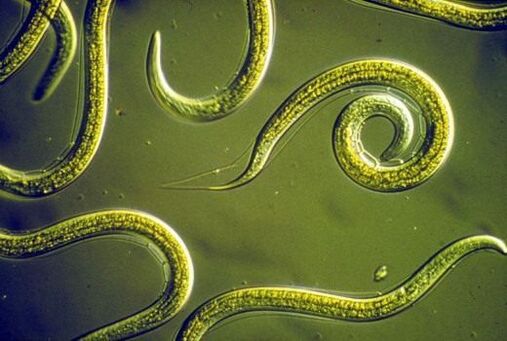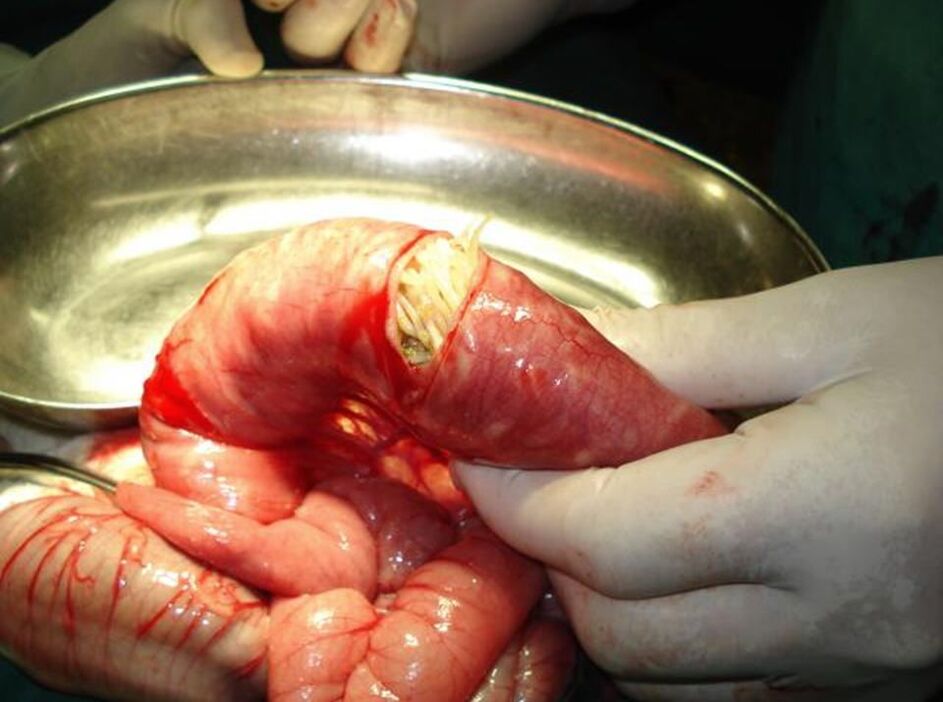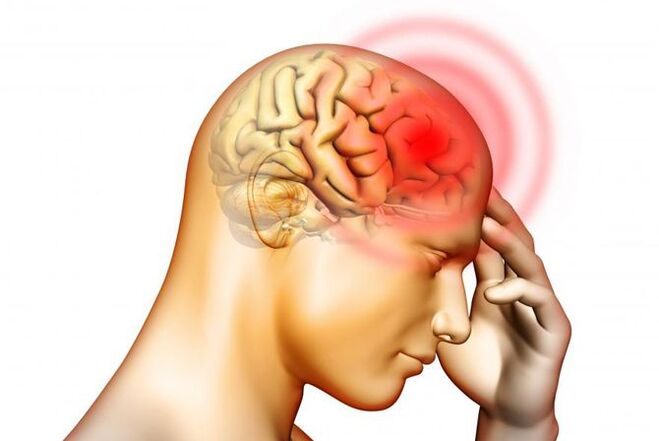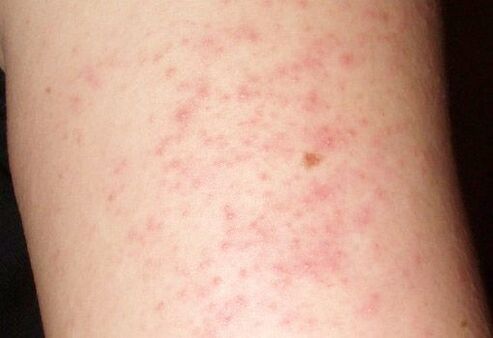Worms in the human body are parasites that are not viable in themselves, they can live and reproduce only through the host (human or animal). Parasitic diseases are caused in humans either by the worms themselves or by their larvae. The disease is contagious, helminthic infestations are not often noticeable, and gradually cause disorders in the body.
First you need to understand what helminths are. This is a general term for worms that parasitize the human body, animals and even plants. This explanation is also the answer to the question of what are worms. The terms "worm" and "helminth" are synonymous.
The most dangerous helminthic infestation is a long-term asymptomatic form that causes diseases caused by malnutrition. Intestinal parasites live by absorbing nutrients from the human body. Helminthic infestation can be detected at an already advanced stage, after the onset of other signs of the presence of intestinal parasites.
Some intestinal parasite larvae can reach various body tissues. In this condition, inflammatory deposits form because the immune system recognizes the larvae as foreign organisms. Some allergic reactions of the immune system can occur as a result of the presence of helminths in humans.
When worms appear in a person, the symptoms and treatment of the invasion are closely related to the cause of the discomfort, ie getting rid of the parasite, and the signs of its presence disappear.
Ways of infection with parasites
There are many factors that cause worms. Their appearance may be due to the following situations:
- One of the most common risk factors for helminthiasis is the impact of mass tourism;
- water and food pollution in the second place;
- helminths can be infected after eating meat products, sausages;
- poorly washed fruits and vegetables are a major source of parasitic larvae;
- Transmission of worms from domestic animals is often recorded.
Symptoms of parasitic diseases
Worm infestations can manifest themselves in different ways depending on the type of parasite. The most common manifestations are:

- constipation - difficulty in bowel movements caused by worms - the result of obstruction of intestinal flow;
- diarrhea - appears due to exposure to substances excreted by parasites, which cause the loss of empty feces potassium and chloride;
- flatulence and swelling - parasites cause inflammation and gas in the small intestine;
- pain in muscles and joints - helminthiases are often characterized by the location of worms even in articular fluids and muscle tissue;
- allergy - parasites perforate the intestinal wall, as a result of which undigested molecules enter the bloodstream and cause an allergic reaction;
- skin problems - with helminthiasis, skin problems such as acne, rashes and itching often occur;
- anemia - parasites attach to the intestinal mucosa and "steal" nutrients, which causes anemia;
- granulomas - a glass-like focus surrounding the eggs of parasites;
- Nervousness - worms produce toxins that irritate the central nervous system, as a result of which psychological symptoms may appear;
- sleep disorders - nocturnal anxiety is accompanied by helminthic invasion for the following reasons: the worms leave the rectum, the activity of the liver increases, trying to get rid of the toxins they produce;
- chronic fatigue is one of the first signs of parasites in the body;
- oncological diseases.

Pinworms
Pinworms are one of the most common intestinal parasites in the human body. These worms are scientifically called Enterobiusvermicularis. They are distributed all over the world. Although these worms are primarily characteristic of the child's body and are most common in groups of children, they are also found in adults.
Infection occurs when the larvae of the parasite are ingested anywhere in the infected person's environment. They are found on the skin, under the nails, in bedding, clothes and dust. In the duodenum, the larvae become adult parasites and then migrate to the large intestine.
Mature pinworms are about 1 cm long, resembling a thin, white thread. They lay eggs in the perianal region. This is manifested by the most characteristic symptoms of the disease - discomfort and itching in the rectal area.
Complications of infection caused by parasites are chronic intestinal inflammation, a secondary vaginal infection in girls.
Two-thirds of people infected with intestinal parasites are unaware of the presence of helminthiasis because they often do not experience symptoms other than restlessness, irritability, and fatigue.
Vlasoqlav

The second most common intestinal parasite is the whipworm Trichuristrichiura. Infections caused by these types of worms are usually asymptomatic, making it very difficult to identify an infected person.
The length of the adult whipworm is 3-5 cm. Worm infestation occurs through the mouth - using contaminated food or water, as well as through contaminated soil. The larvae of the parasite nest in the small intestine, and adult worms build nests in the large intestine. The adult female lays eggs in the feces and lays eggs in warm soil after 5 weeks of nesting.
In the worst case, the lashes only cause abdominal pain, diarrhea or nausea. More serious complications of this infection occur only in the tropics. In severe cases, chronic diarrhea or anemia may occur.
Nematodes
Human nematodes include 2 types of parasites - Ancylostomaduodenale and Necatoramericanus. Adult females are 10-13 mm (A. duodenale) or 9-11 mm (N. americanus), males are 8-11 mm (A. duodenale) and 7-9 mm (N. americanus).

Eggs are excreted in the feces of the host. Under favorable conditions (humidity, heat), the larvae hatch in the soil or feces within 1-2 days, and after 5-10 days they become larvae that can transmit the infection. Under favorable natural conditions, they can live 3-4 weeks.
Contact with the human body occurs when parasitic larvae penetrate the skin. It reaches the heart and lungs through the bloodstream, penetrates the alveoli of the lungs, then enters the pharynx through the bronchial tree and is swallowed. The larvae reach the small intestine and stay there for as long as they need to develop into adult worms.
Adult worms live in the small intestine, attach to the intestinal wall and feed on the blood of the host, a human being. Most of these parasites are eliminated from the body within 1-2 years, but their parasitic notes in the body can last for decades.
The larvae of A. duodenale worms that penetrate human skin are immobile (both in the intestine and in the muscle). In addition, A. duodenale parasitic infection can also be transmitted orally. However, the N. americanus worm requires migration.
Round worm
Roundworms - Ascarislumbricoides - also belong to the intestinal parasites. An adult worm can grow up to 25 cm in length. In this type of person, helminths remain hidden for a long time. Their symptoms are most often fatigue and cough, most often due to other reasons.
It is enough to use unwashed vegetables and fruits for helminthiasis.

The larvae of these worms build a nest in the small intestine and hatch from the egg, penetrating the intestinal wall. Reaches the lungs through blood and lymph flow and causes coughing. During coughing, the greenish mucus is cleared and returns to the intestines after being swallowed by roundworms. Ascaris eggs are excreted in the feces.
The most common source of infection in humans is infected human feces.
In severe cases, ascaris can cause inflammatory processes in the body, most often pneumonia. However, in most cases, people infected with worms remain asymptomatic or the symptoms are so mild that neither the patient nor the attending physician initially suspects an infection with intestinal parasites.
The disease caused by ascaris is called ascariasis. The main route of infection is feces.
The WHO estimates that worms infect about 1 billion people a year.

In adults, helminths, the symptoms and treatment of which depend on the location of the worms, are characterized by a variety of clinical manifestations - from asymptomatic forms to severe and even fatal. Common symptoms include abdominal discomfort and pain, diarrhea, rectal itching, or allergic reactions. First, the larvae of parasites in the migratory phase can cause signs of inflammation of the lungs (Loeffler's syndrome), pancreas, heart muscle, liver and other organs.
Roundworms in the intestines are the cause of metabolic disorders and disorders of the nervous system.
Ascaris in the respiratory organs
When worms migrate in the human body, they pass through the esophagus, where they colonize the lymph nodes around the main lymphatic chain (Valdeyer's chain).
Where worm larvae can be:
- lymph and salivary glands;
- pharynx;
- larynx;
- area along the ear canals leading to the middle ear;
- all the connections to the brain.
The walls of the lateral nasopharynx have openings leading to the Eustachian tube that connects the pharynx to the middle ear. This allows the pressure in the ear to balance with atmospheric pressure. In these ways, the larvae of worms can reach the middle ear. As a result, hearing deteriorates, tinnitus appears, headache and Meniere's syndrome - dizziness, accompanied by moments of memory loss.

Pulmonary manifestations of ascaris
Ascaris lesions of the lungs cause diseases of this organ and symptoms in the form of roughness and rash on the skin. These symptoms are accompanied by a slightly elevated temperature, but sometimes fever. The person suffers from dry cough, asthmatic bronchitis and noise. Untreated pulmonary ascariasis can become a chronic problem with seasonal inflammation and can result in severe bronchial asthma. He is addicted to drugs and sometimes even retires with a disability pension.
Roundworms in other organs
Due to the colonization of other organs by the larvae of worms, they show signs of minor bleeding and inflammation. They can penetrate the pancreas, bile ducts and liver. In the small intestine, the larvae combine to form a lump and form an ileus. Parasitic larvae live in the above-mentioned organs throughout their lives, feed on their metabolites and mechanically damage them.
They can penetrate the pancreas, bile ducts and liver. In the small intestine, the larvae combine to form a lump and form an ileus. Parasitic larvae live in the above-mentioned organs throughout their lives, feed on their metabolites and mechanically damage them.
With the presence of larvae in the liver and bile ducts, the liver weakens and is unable to excrete toxins naturally. As a result, they are excreted through the skin, causing allergies, itchy rashes, subcutaneous swelling of "unknown" origin and many other manifestations in many variations, from dry eczema to purulent processes.
Ascaris in the brain
Symptoms of cerebral invasion vary depending on the location of the larvae. If they are in the meninges, there is a risk of meningoencephalitis with migraine headaches. During the colonization of the threads, granulomas form in the gray crust.
Then the symptoms of brain cancer appear: fainting, epileptic seizures, convulsions. If the granuloma is located near the optic or auditory nerve, deafness or visual disturbances appear.
Tapeworm
Chaeniasaginata, Taeniasolium - is one of the oldest and most popular intestinal parasites. It can reach a record length - up to 9 m.

The two most common types of worms are cattle (Taeniasaginata) and pork tapeworm (Taeniasolium). Both types colonize the body after consuming raw or undercooked meat. The eggs of the parasite are elongated and placed in the small intestine. Adult worms develop after 3 months. The last parts of the worm's body are filled with eggs, which are released separately and excreted in the feces. Larvae have the ability to enter the bloodstream through the intestinal mucosa, and then migrate to the muscles and brain.
Despite the severity of the disease, tapeworm does not necessarily cause symptoms of its presence, so it remains invisible for a long time. Chains in the muscles cause muscle pain, in the brain - epileptic seizures.
The parasite is detected by X-ray or computed tomography. Only on the basis of these studies can an accurate diagnosis be made.
Parasite treatment
Worms are treated differently. These include both the popular use of antiparasitic herbs and the most modern bioresonance therapy.
Antiparasitic herbs
The rules for the use of antiparasitic herbs are based on the localization of worms in the body.

It is recommended to take half an hour before meals in the following cases:
- parasites in the intestines and lower body;
- secondary infection with worms of the genitourinary system.
Application with food: damage by parasites of the stomach, colon, liver and spleen.
Use after meals: parasitic infection in the upper body, lungs, neck, head.
Recommendations for the use of antiparasitic herbs:
- not recommended for pregnant women;
- Wormwood, one of the most commonly used herbs for worms, should not be used for gastric ulcers.
Chemical antiparasitic drugs
The most effective are preparations containing carbamic acid methyl ester. This active ingredient is designed to treat pinworms, whipworms, roundworms, tapeworms. When treating pinworms, dosing is carried out according to instructions. Treat other parasites with these drugs according to age.
It is important to follow the dosage to prevent cramps.

Application of therapeutic frequencies in a bioresonance device and treatment using a plasma generator
These devices destroy pathogens in the body without any adverse effects. When using a bioresonance device, electrical impulses pass through the tissues, and when using a plasma generator, the parasite passes through radio waves that cause the membrane to vibrate. The result is the rupture of membranes and the consequent destruction of parasites. A specific frequency is applied to each type of microorganism.
It is very important to follow the regimen during this treatment of worms: exclusion of alcohol consumption and subsequent detoxification. Dead worms must be removed from the body, otherwise they will be encapsulated and act as allergens.
All existing parasites are treated and destroyed by these methods. Therapy is carried out in 2 stages:
- stage 1: removal of small parasites - 20 minutes for each microorganism;
- stage 2 - removal of large worms - is applied frequently to destroy first the eggs, then the larvae and finally the adult worms.
Optimal time of treatment:
- Unicellular: plasma - 5 minutes per frequency; bioresonance - 20 minutes per frequency.
- Multicellular: plasma - 10 minutes per frequency; bioresonance - 4 × 20 minutes using a frequency of 1.
The use of a plasma generator, in addition to a significant reduction in the duration of the procedure, has another major advantage - when used, it can be up to 5 people with animals at the same time. Its range is up to 5 m.
The result
Treatment of worms involves the removal of sugar, baked goods and potatoes - these foods create an ideal environment for helminths to live.
In the case of treatment of the child, it is recommended to give him roasted pumpkin seeds for chewing - about 30 seeds 3 times a day. Do not eat them with staple foods.
Eating raw garlic in moderation will also help eliminate worms.
Getting rid of worms will not work without proper hygiene. Washing hands, bedding and dishes frequently are the basis of effective therapy.




























